AMD’s 5 GHz Turbo CPU in Retail: The FX-9590 and ASRock 990FX Extreme9 Review
by Ian Cutress on August 9, 2014 8:00 AM ESTGaming Benchmarks
F1 2013
First up is F1 2013 by Codemasters. I am a big Formula 1 fan in my spare time, and nothing makes me happier than carving up the field in a Caterham, waving to the Red Bulls as I drive by (because I play on easy and take shortcuts). F1 2013 uses the EGO Engine, and like other Codemasters games ends up being very playable on old hardware quite easily. In order to beef up the benchmark a bit, we devised the following scenario for the benchmark mode: one lap of Spa-Francorchamps in the heavy wet, the benchmark follows Jenson Button in the McLaren who starts on the grid in 22nd place, with the field made up of 11 Williams cars, 5 Marussia and 5 Caterham in that order. This puts emphasis on the CPU to handle the AI in the wet, and allows for a good amount of overtaking during the automated benchmark. We test at 1920x1080 on Ultra graphical settings.
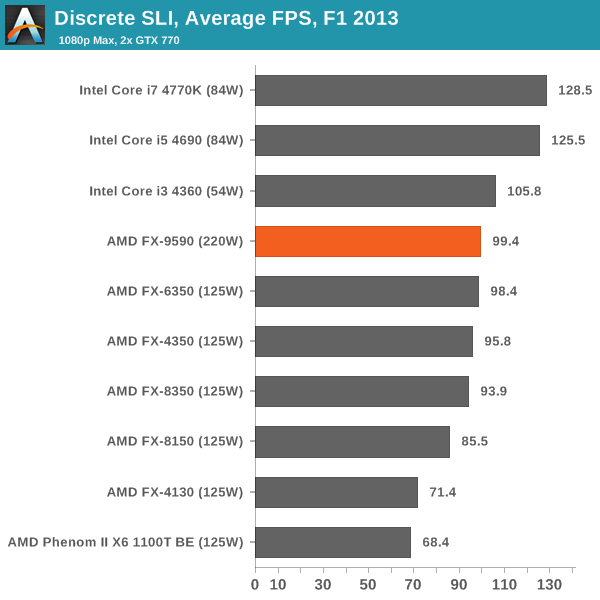
The FX-9590 seems to match the i3-4360, indicating that even more cores, more frequency and more PCIe lanes is not always a good thing. The i3-4360 is using PCIe 3.0 x8/x8, compared to PCIe 2.0 x16/x16 for the FX-9590, which should put them both equal in bandwidth.
Bioshock Infinite
Bioshock Infinite was Zero Punctuation’s Game of the Year for 2013, uses the Unreal Engine 3, and is designed to scale with both cores and graphical prowess. We test the benchmark using the Adrenaline benchmark tool and the Xtreme (1920x1080, Maximum) performance setting, noting down the average frame rates and the minimum frame rates.
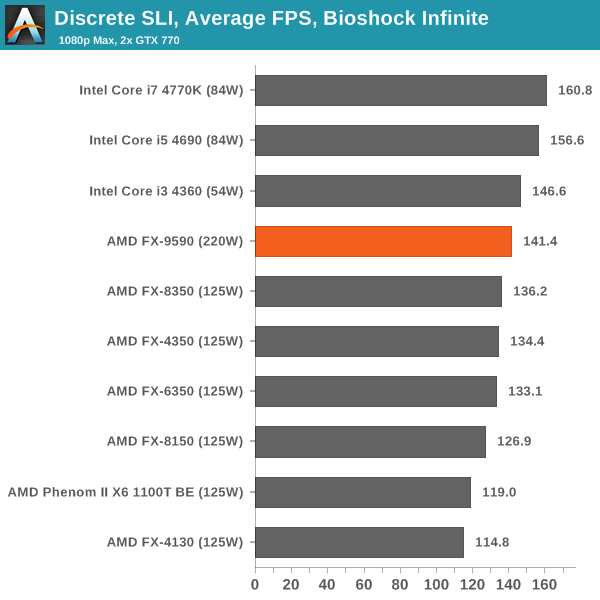
Again, the FX-9590 is trading around the Haswell i3 margin.
Tomb Raider
The next benchmark in our test is Tomb Raider. Tomb Raider is an AMD optimized game, lauded for its use of TressFX creating dynamic hair to increase the immersion in game. Tomb Raider uses a modified version of the Crystal Engine, and enjoys raw horsepower. We test the benchmark using the Adrenaline benchmark tool and the Xtreme (1920x1080, Maximum) performance setting, noting down the average frame rates and the minimum frame rates.
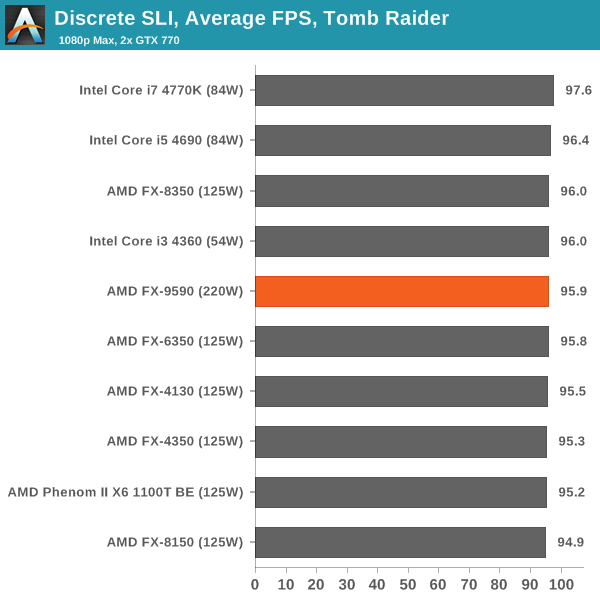
Tomb Raider has historically been CPU agnostic, with all the latest CPUs performing similarly.
Sleeping Dogs
Sleeping Dogs is a benchmarking wet dream – a highly complex benchmark that can bring the toughest setup and high resolutions down into single figures. Having an extreme SSAO setting can do that, but at the right settings Sleeping Dogs is highly playable and enjoyable. We run the basic benchmark program laid out in the Adrenaline benchmark tool, and the Xtreme (1920x1080, Maximum) performance setting, noting down the average frame rates and the minimum frame rates.
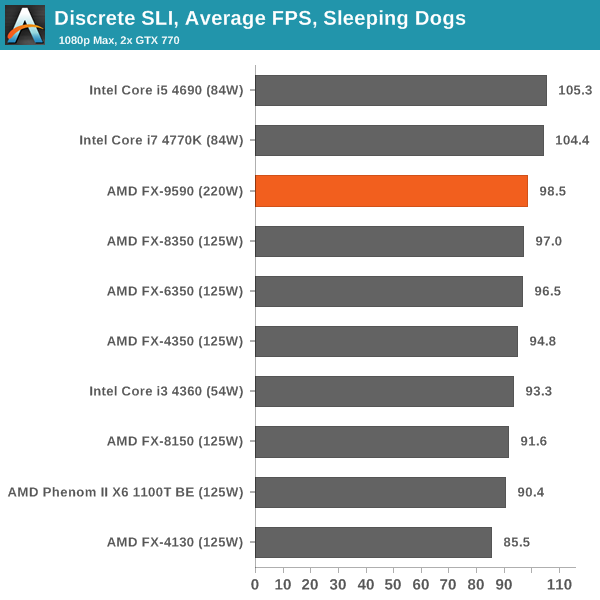
The FX-9590 loses 4-6 FPS on average to the latest Intel cohort, which is not bad considering the release date difference.
Company of Heroes 2
Company of Heroes 2 also can bring a top end GPU to its knees, even at very basic benchmark settings. To get an average 30 FPS using a normal GPU is a challenge, let alone a minimum frame rate of 30 FPS. For this benchmark I use modified versions of Ryan’s batch files at 1920x1080 on High. COH2 is a little odd in that it does not scale with more GPUs with the drivers we use.
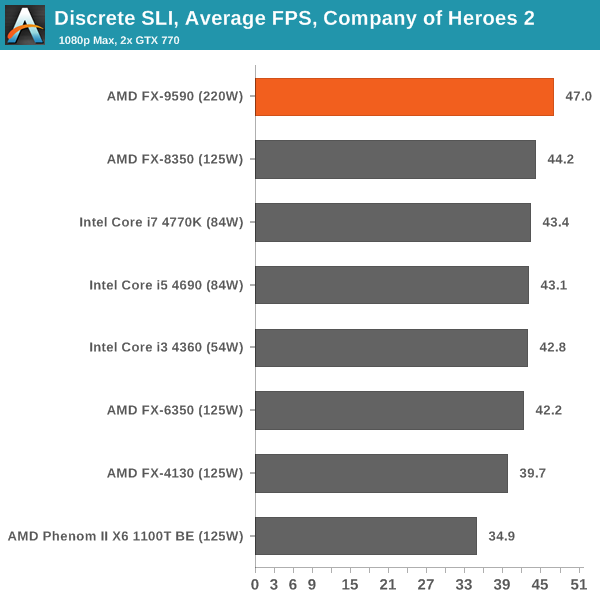
Company of Heroes 2 is usually relatively CPU agnostic except for the older dual core CPUs, but the FX-9590 gets a win here.
Battlefield 4
The EA/DICE series that has taken countless hours of my life away is back for another iteration, using the Frostbite 3 engine. AMD is also piling its resources into BF4 with the new Mantle API for developers, designed to cut the time required for the CPU to dispatch commands to the graphical sub-system. For our test we use the in-game benchmarking tools and record the frame time for the first ~70 seconds of the Tashgar single player mission, which is an on-rails generation of and rendering of objects and textures. We test at 1920x1080 at Ultra settings.
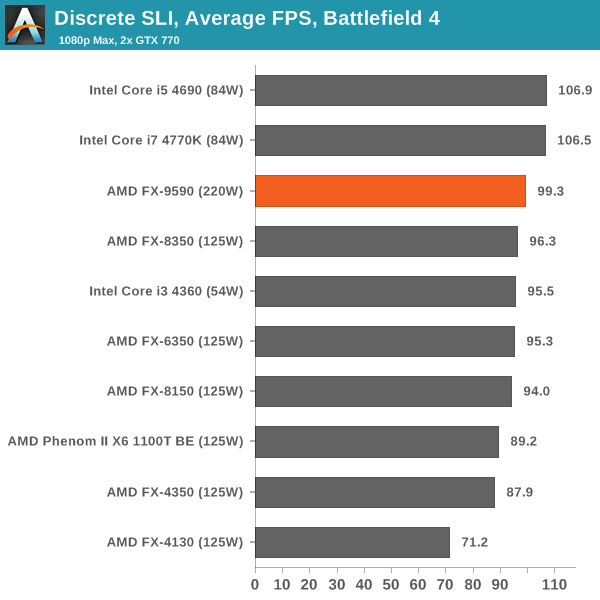
Similar to Sleeping Dogs, the FX-9590 does not lose much considering the release date difference of the architectures.






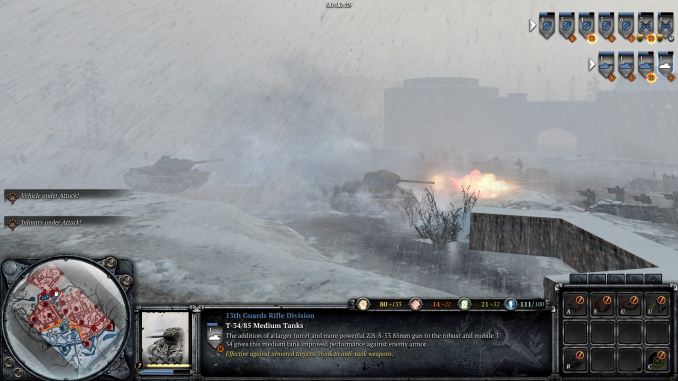









146 Comments
View All Comments
Flunk - Saturday, August 9, 2014 - link
The likelyhood of an existing AM3+ owner having a board that can support a 250watt CPU is pretty low, there really aren't many options. This CPU is a real turkey and people are not buying them.TiGr1982 - Saturday, August 9, 2014 - link
220 W, not 250, but this does not change your statement :)basroil - Sunday, August 10, 2014 - link
220W TDP, the chart above shows it uses 237W without overclocking! AMD needs to get their stuff togethertakeship - Sunday, August 10, 2014 - link
Yeah, AMD's "220" is 220w of heat, not necessary 220w of power. You'll measure more, maybe a lot more, at the wall.Death666Angel - Sunday, August 10, 2014 - link
That is the whole system, the mainboard, the drives, dedicated graphics card, conversion loss by your PSU. Get your facts straight.@takeship: Where would that 220W of heat come from is not from the power? Does the CPU somehow produce more heat from chemical reactions?
anubis44 - Sunday, August 10, 2014 - link
Well, one pro is that you get a processor that is fairly comparable to an Intel i7 in performance, and most importantly, you'll be giving your money to a company that didn't try to screw you by attempting to corner the market through extortionate threats to their own OEM customers if they used AMD CPUs when they were better than Intel's.In other words, there may not be any technical advantages over Intel's competing products, but there are also no significant disadvantages, and at least by buying AMD, you won't feel like you need to take a bath afterwards to wash the filth off. I say to hell with Intel. Stop giving them money as punishment for their gangsterism.
asoltesz - Wednesday, August 13, 2014 - link
Mostly, this is why I bought an AMD desktop last year. It was similar in price than an Intel-one would have been for the same money. It consumes much more energy but that was something I could put up with.FITCamaro - Saturday, August 9, 2014 - link
Man I seriously don't want to live in England if your electricity is that expensive. That's $0.30 cents/kWh. But with our current president and administration who want our electricity prices to rise, we might soon be in that boat. I pay about $0.06/kWh.lkb - Saturday, August 9, 2014 - link
Here in germany we pay 54 Euro Cents/kWh during peak times. While it sucks it has it upsides too - no stupid bitcoin mining crazy to speak of around here!TiGr1982 - Saturday, August 9, 2014 - link
Well, then I doubt you will go with FX - even despite the fact, that FX CPU dies are actually produced in Germany at Drezden GloFo Fab 1 :)